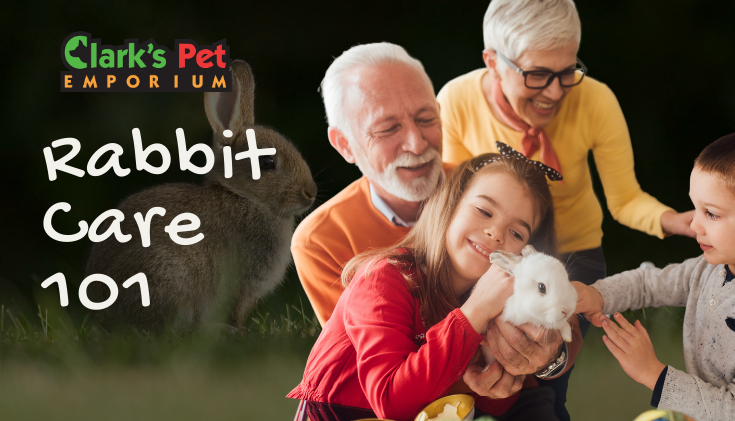FEEDING
The 3 most important foods for a rabbit are hay, hay, and HAY! Contrary to popular belief, rabbits do not need salt licks, vitamins, or hard wooden objects to wear their teeth down. Teeth are kept worn to a proper length by the silicate and lignin content of grass and grass. hays. Do not offer rabbits plants, vegetation, or tree branches unless you are. sure they are not harmful.
- Limited pellets (plain only! no seeds, nuts, colored tidbits): 1/4 cup, per 5 ft. of body weight per day.
- Dark -green leafy veggies daily if possible (good job for volunteers!). Good veggies: all leaf lettuces, dandelion greens, kale, collards, turnip greens, mustard greens, parsley, cilantro, basil, Avoid: cabbage, broccoli, cauliflower, brussel sprouts, spinach.
- Limited amounts of sweet veggies such as carrots.
- Occasional treats in very low quantities: slice of apple, slice of banana, a -few, hulled sunflower seeds, 2-inch piece of carrot. For more frequent treats, use fragrant herbs such as cilantro, parsley, arugula, basil, et al. Do not feed bread or-other high-carbohydrate foods, as they can. lead to intestinal dysbiosis.
- Fresh water, changed daily. Double check to see that steel tall in bottle is working properly each. time you hang the bottle. Bowl (changed daily) encourages more drinking, but bowl. must be heavy crock to prevent tipping.
HOUSING
- Indoor housing is essential. Domestic rabbits can die from heart attacks at the very approach. of a predator. Other outdoor concerns: fleas (anemia, West Nile virus), ticks, VHD, Baylisacaris procyonis (raccoon roundworm), fly strike.
- Intact male and female rabbits must be separated by sex and housed separately. “Accidental” litters occur is shelters with distressing frequency. A doe can have a litter every 30 days, and can get pregnant within 30 mins. of giving birth. Immature rabbits can be hard to sex. Ask for expert help if you have any doubts.
- Wire flooring can cause and/or exacerbate hock problems, which can become serious enough to require amputation. Use ordinary cat or dog cages, or cover wire flooring with sections of newspaper (can be messy if bunny digs) or plain, brown corrugated cardboard. If dog cages are used, check to be sure the spacing between the cage wires is small enough to prevent a rabbit’s head or limbs from getting stuck.
- Place rabbits away from extreme heat. Avoid placing rabbits on top tier of cages if possible -especially in summer.
- Avoid placing rabbits in the same room with barking dogs if possible. Rabbits usually adapt quickly to barking heard from a distance. Avoid placing rabbits across from (or in full view of) cats.
- Litter-trained rabbits are more easily adopted. Shelter rabbits will usually use litterboxes readily, if the box is place in the corner the rabbit has chosen for urination. Line litterbox with section of newspaper and fill with grass hay. Dump daily. Avoid pine and cedar chips as bedding or litter material; aromatic phenols can potentiate liver enzymes and irritate respiratory tract.
- A cardboard “hidey box” placed in the cage can make a rabbit feel more secure. However, this may increase territorial behaviors – particularly in unspayed females. Boxes are most useful in wire cages, where the rabbit has no other means of hiding himself.
GENERAL CARE & SOCIALIZATION
- If possible, have rabbits spayed/neutered before adoption. If this is not possible, include spay/neuter as part of adoption contract, and take deposit to be returned upon presentation of proof of surgery. Besides preventing accidental litters, spaying prevents uterine cancer (which can reach 50-80% as rabbits age), and neutering reduces spraying and other hormonedriven behaviors.
- Converted dog runs make great rabbit exercise areas. Use donated carpet scraps (or inexpensive, rubber-backed runners) to offer the rabbit traction for running and jumping.
If possible, talk to the rabbit calmly and stroke him daily. Rabbits are highly social animals who thrive on attention and social interaction. Many rabbits are very overtly affectionate, and will nuzzle and lick their handlers. Others are shyer and more “laid back.” - Do not approach the rabbit from directly in front (unfortunately, shelter cages leave you few alternatives). Rabbits have laterally placed eyes and cannot see up close, directly in front of themselves.
- When working with an unfamiliar rabbit, pat the rabbit gently between the eyes, til he relaxes, before picking him up. Never attempt to lift a rabbit who is struggling. Rabbits can easily break their own backs attempting to get away from perceived predators (us!).
- Lift the rabbit by supporting his hindquarters and forequarters simultaneously. If the rabbit struggles to get down once lifted, lower yourself (and the rabbit) as close as possible to the floor to prevent injury.
- Rabbits love “projects” – i.e. objects in their environments that they can move and manipulate. These provide stimulation and exercise. Offer plain brown, corrugated cardboard boxes for chewing and “interior desecration.” Plain, non-toxic wooden or hard plastic baby toys can also be appropriate “toys” for rabbits.
- Always remember that rabbits are a prey species. The more predictable their environment and the more securely they are handled, the more relaxed and sociable they become. Many rabbits relinquished to shelters have been severely traumatized in their former environments. They may have learned to survive by nipping or boxing. These behaviors can usually be eliminated by correct handling and social interaction.
- Rabbits are highly territorial, and may also attempt to nip or box when their territory is “invaded.” This is especially true of unspayed females. This behavior is entirely normal, and is usually greatly reduced by spaying/neutering. If a rabbit boxes when you offer food or clean the cage, place one hand on the rabbit’s head and gently press and rub, while using the other hand to remove food bowl, litterbox, etc.
- A rabbit who has suddenly stopped eating or whose eating patterns have suddenly changed needs immediate veterinary attention.
If you have any questions, please give us a call at (505) 293-5977 !
*Info provided by SPCA.

